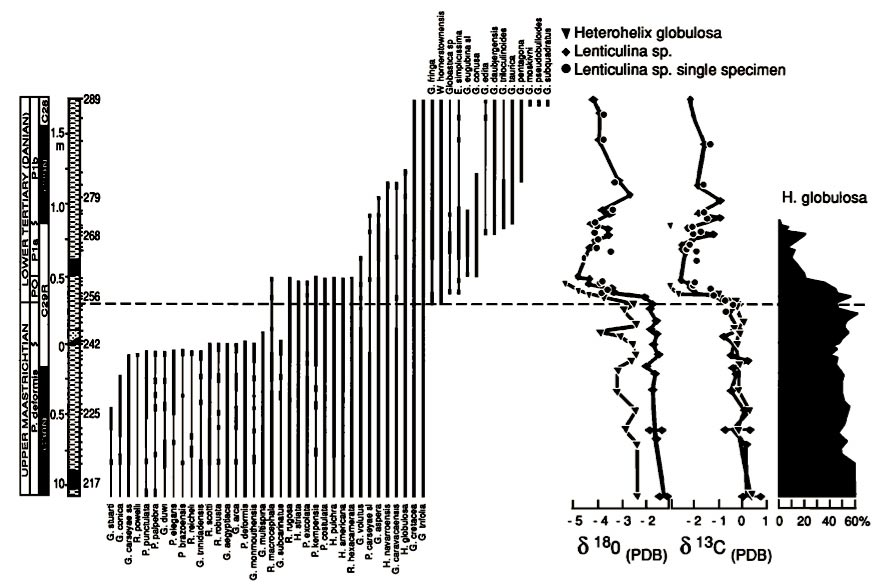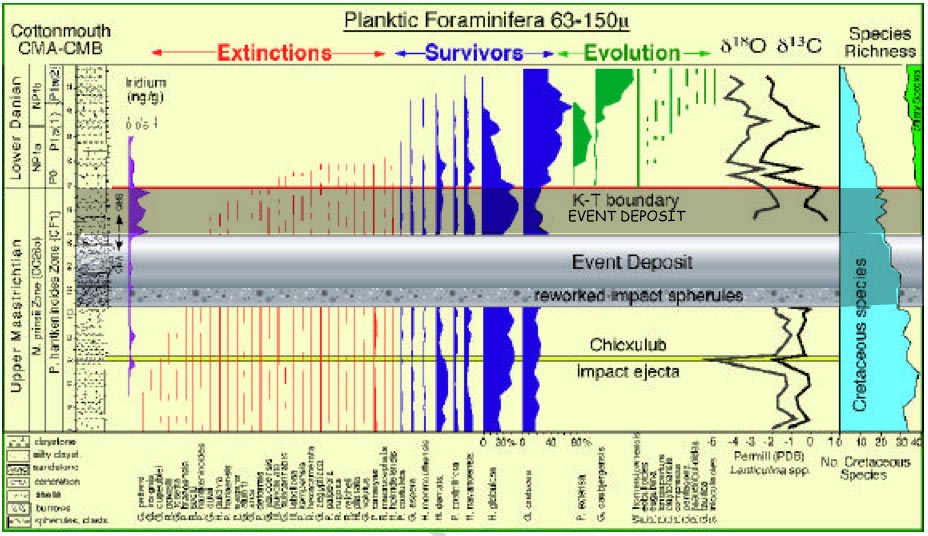 |
| The figure from Barrera and Keller 1990, quoted above (top) |
| Comments (here below) to: Gerta Keller, Thierry Adatte, Gerald Baum, Zsolt Berner, Reply to ‘Chicxulub impact predates K-T boundary: New evidence from Brazos, Texas’ Comment by Schulte, Speijer, Brinkhuis, Kontny, Claeys, Galeotti & Smit, Earth and Planetary Science Letters (2008) in press, doi: 10.1016/j.epsl.2007.12.025 |
2.2. K-T d 13C shift |
| "Schulte et al. extensively criticize our d13C data {0} while ignoring the previously published record of the Brazos section {1}[24], which would have obviated the need for this discussion. One of their misconceptions is that there is a "strong diagenetic overprint" because the d13C curve parallels the calcite content. Barrera and Keller [24] demonstrated that (1) foraminiferal shell preservation is pristine{2}, and (2) that the gradual d13C shift in Lenticulina and H. globulosa{3} is not due to reworking, but evidence that H. globulosa survived the K-T mass extinction. Our data parallels this record. In addition to Lenticulina , we also analyzed fine residues (38-63micron), rather than bulk rock, because contrary to their assertion, the fines consist mainly of small planktic foraminifera, whereas bulk rock can be biased by large benthics. The very low negative (-7?) values in the coarse grained event deposit and clasts are due to secondary calcite precipitated from isotopically light meteoric water. In contrast to the sudden d C shift in condensed deep-sea sections, the K-T shift is gradual at Brazos due to the expanded record, gradually reduced diversity and productivity (Fig. 2) [19, 24]. The same gradual{4} pattern was observed at the similarly shallow Stevns Klint section of Denmark [20]. The sudden d13C shift observed in deeper distal sections noted by Schulte et al. is usually the result of condensed sedimentation.{5} " |
| {0}We criticized these data, because the curves given were considered an ocanographic signal, while there is obviously a large diagenetic overprint. Normally, benthic ∂13C values are lower than planktic values because of the oceanic ∂13C gradient. If the small bulk fraction consist, as Keller2008 insists, of small planktic foraminifera, than a value similar or lower than the benthics is highly suspect (see overlay curves). For the event deposit Keller2008 are now willing to admit there might be some diagenetic overprint, but the negative ∂13C values of the small fraction are overall much lower than would be expected for calcite precipitated in seawater. The benthic (Lenticulina) values, are compatible with published benthic oceanic values (Zachos et al 1986). As shown in Barrera1990, the test walls of these benthics are well preserved and are thick with repect to chamber size, so calcite infill will have less influence on the data. |
| {1} We have reproduced this record here below. It does not differ from the figure 2 of Keller2008, which is at least consistent! However, these d13C data are very difficult to interpret, because they are most likely the result of a mixture of reworked forams, calcite infills and shell material. Therefore these data of this figure are questionable as representation of oceanographic changes across the KT boundary, as these curves by Keller et al suggest. |
| {2} Shell preservation is good, but we think that is not measured throughout the section by Barrera! Although Barrera1990 (see original text) claim that they ultrasonically cleaned the inside of the foraminiferal shells, it is our experience that the calcite infilling of Danian specimens cannot be removed by this technique. This means they dominantly must have measured the diagenetic calcite infilling. |
| {3}Barrera1990 say ..." This small d13C difference between planktonic and benthonic values may reflect H. globulosa's habitat within an oxygen deficient layer in the water column and/or disequilibrium precipitation of either H. globulosa or Lenticulina sppTertiary ". It could also mean that the differences were minimized because they contain the same calcite infilling. |
| {4} Note that this gradual shift parallels the relative abundance of Hh globulosa. Schulte et al criticized the fig 3 of Keller2007, because in contrast to the figures 1 and 2 of Keller2008, the d13C curve is indiscriminately drawn through marl, sandstone and graded clay deposit, suggesting these all are pure oceanographic changes, while the majority may be due to calcit infilling. Now Keller disregards the data from the sandstone (finally) as reworked. |
| {5}Some of these sections (Caravaca, Agost Zumaya) are not condensed, and still show the sharp ∂13C shift. |
 |
| The figure from Barrera and Keller 1990, quoted above (top) |
MATERIALS AND METHODS (original text from Barrera and Keller 1990)
Foraminiferal and sediment samples analyzed in this study were taken from the stratigraphic levels in the core indicated in Figure 2 and listed in Table 2. We isotopically analyzed specimens of the planktonic foraminiferal species Heterohelix globulosa in the size fraction between 150 and 65 ·m, whereas those of the benthonic foraminifera Lenticulina spp were larger than 250 ·m. Isotopic analyses of Lenticulina spp were done on samples containing multiple specimens as well as a single specimen. Those tests with the best preservation, as discussed below, were selected for isotopic analysis. It was not possible to isolate sufficient nannofossils from the sediment for isotopic measurement and to obtain an additional record of near- surface water conditions. Instead undifferentiated carbonate in sediment samples referred as "bulk carbonate" was analyzed. Thin section observations indicate that this material represents a variable mixture of foraminifera, nannofossils and diagenetic carbonate Paleocene sediments [Smit, 1977; Gerstel et particles, with the later increasing in al., 1986], but their presence was frequently interpreted as being due to redeposition of Cretaceous sediments. The main problem has been the difficulty in identifying in situ versus redeposited specimens. Redeposited specimens are generally identified by their poorer preservation relative to the in situ fauna and by their presence in younger sediments than the age of their supposed disappearance from the record. The later criterium is a hindrance in Danian abundance in uppermost Maastrichtian and Tertiary sediments (Table 1). Sediment samples were processed according to standard micropaleontological techniques [Keller, 1986]. Before isotopic analysis, extraneous material inside foraminiferal chambers was removed by ultrasonic agitation of the tests in distilled water. This was not possible when only one specimen was analyzed and consequently, we selected specimens that contained little infilling material.
 |
| Broken chamber of a Danian foraminifer showing the calcite filling inside it. The chamberwall looks deceptively well preserved, but when the whole specimen is dissolved, results will be dominated by the infill. These infills occur invariably in those foraminifers and are not easily removed by ultrasonic cleaning (top) |
 |
| Fig 1 of Keller et al 2008 (see also here) (top) |
 |
| Fig 2 of Keller et al 2008 (see also here) (top) |
|
|
| Figure 3 of Keller2007, which we criticized. (top) |
| REFERENCES |
| Keller, G., T. Adatte, et al. (2007). "Chicxulub impact predates K-T boundary: New evidence from Brazos, Texas." EPSL 255(3): 339-356. |
| Peter Schulte, R. P. S., Henk Brinkhuis, Agnes Kontny, Philippe and S. G. Claeys, Jan Smit (2008). "Comment on the paper: ”Chicxulub impact predates K-T boundary: New evidence from Brazos, Texas” by Keller et al. (2007) ." Earth and Planetary Science Letters In Press Accepted Manuscript, Available online 11 January 2008. |
| Gerta Keller, T. A., Gerald Baum and Zsolt Berner (2008). "Reply to ‘Chicxulub impact predates K-T boundary: New evidence from Brazos, Texas’ Comment by Schulte et al. ." Earth and Planetary Science Letters In Press, Accepted Manuscript, Available online 17 January 2008. |
| Zachos, J. C. and M. A. Arthur (1986). "Paleoceanography of the Cretaceous/Tertiary boundary event: inferences from stable isotopic and other data." Paleoceanography 1(1): 5-26. |
Barrera, E. and G. Keller (1990). "Stable isotope evidence for gradual environmental changes and species survivorship across the Cretaceous/Tertiary boundary." Paleoceanography 5: 867-890. (top) |
 |
| Overlay of the Lenticulina ∂13C over the small planktic fractions of keller2007 figure 3. red=small planktic, green = Lenticulina (modified from original fig3) |